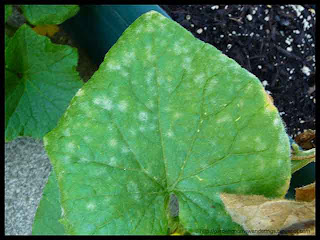My experience with zucchini and cucumber is they tend to be prone to powdery mildew. Powdery mildew in the cucurbit family is is a fungal disease caused by Sphaerotheca fuliginea. In severe cases it will destroy the entire plant as well as spreading to healthy plants. As with any plant disease recognizing and treating the problem early can make a huge difference as to whether the crop is saved.
Powdery mildew shows up as light blueish grey fuzzy spots on the leaves. The spots will get larger eventually covering the entire leaf that will then shrivel and die. Fungus propagate via spores so the disease can spread rapidly. It is very important to not work in the garden when the foliage is wet as that will hasen the spread of fungal diseases.
Controlling powdery mildew in the home garden can be easily achieved by spraying the leaves regularly with chamomile tea, a baking soda solution or a milk solution. My experience has been the milk solution is the most effective with result seen within a couple of hours of spraying. One of the reasons for this is milk acts as a foliar fertilizer that boosts the plant's immune system helping it fight off the disease via its germicide properties.
A 10% (1 part milk to 9 parts water) solution sprayed weekly of milk is enough to control powdery mildew. Too strong of a solution can cause odours and an innoccuous to grow on the plants. I use 3 tbsp spoons of skim milk powder in one litre of water for the first treatment then reduce the skim milk powder to 2 tbsp for each treatment there after. I spray the milk solution on all of the leaves to curb any further outbreaks. This effectively kills off the initial powdery mildew outbreak and any further outbreaks. I also cut away any dead leaves that may harbour the fungal spores. The milk treatment is effect, low cost and organic.
Happy Gardening!
Garden Gnome
©2006-2010






















0 comments:
Post a Comment
Thanks so much for commenting. Your message will appear once approved.